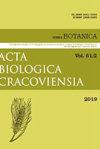TYROSOL GLUCOSYLTRANSFERASE ACTIVITY AND SALIDROSIDE PRODUCTION IN NATURAL AND TRANSFORMED ROOT CULTURES OF RHODIOLA KIRILOWII (REGEL) REGEL ET MAXIMOWICZ
IF 0.4
4区 生物学
Q4 PLANT SCIENCES
引用次数: 5
Abstract
The study examined tyrosol glucosyltransferase activity and the efficiency of salidroside production in natural and transformed root cultures of Rhodiola kirilowii (Regel) Regel et Maximowicz. Neither enzyme activity nor salidroside accumulation were detected in natural and transformed root cultures maintained in media without tyrosol. To induce TGase activity in biotransformation reactions, tyrosol was added to natural and transformed root cultures on the day of inoculation. The first peak of TGase activity (0.23 U/μg) was detected on day 9 in natural root culture, accompanied by the highest salidroside content (15.79 mg/g d.w.), but TGase activity was highest (0.27 U/μg) on day 15. In transformed root culture, day 18 showed the highest TGase activity (0.15 U/μg), which coincided with the highest salidroside content (2.4 mg/g d.w.). Based on these results, tyrosol was added to the medium on the days of highest previously detected activity of TGase: day 15 for natural root cultures and day 18 for transformed root cultures. This strategy gave significantly higher yields of salidroside than in the cultures supplemented with tyrosol on the day of inoculation. In natural root culture, salidroside production reached 21.89 mg/g d.w., while precursor feeding in transformed root cultures caused a significant increase in salidroside accumulation to 7.55 mg/g d.w. In all treatments, salidroside production was lower in transformed than in natural root cultures.红景天天然和转化根培养中酪醇葡萄糖基转移酶活性和红景天苷的产生
研究了红景天(Rhodiola kirilowii, Regel)和红景天(Regel et Maximowicz)天然根培养物和转化根培养物的酪醇葡萄糖基转移酶活性和红景天苷生产效率。在不添加酪醇的培养基中,天然和转化根培养均未检测到酶活性和红景天苷积累。为了在生物转化反应中诱导TGase活性,在接种当天将酪醇添加到天然和转化根培养物中。自然根培养第9天时,TGase活性达到第一个峰值(0.23 U/μg),红萝卜苷含量最高(15.79 mg/g d.w.),第15天时,TGase活性最高(0.27 U/μg)。在转化根培养中,第18天TGase活性最高(0.15 U/ g),红萝卜苷含量最高(2.4 mg/g d.w)。根据这些结果,在TGase活性最高的日子添加酪醇到培养基中:自然根培养第15天,转化根培养第18天。与接种当天添加酪醇的培养相比,该策略显著提高了红景天苷的产量。在自然根培养中,红景天苷的产量达到21.89 mg/g d.w,而转化根培养中前体的摄食使红景天苷的积累量显著增加,达到7.55 mg/g d.w。在所有处理中,转化根培养的红景天苷产量均低于自然根培养。
本文章由计算机程序翻译,如有差异,请以英文原文为准。
求助全文
约1分钟内获得全文
求助全文
来源期刊
CiteScore
3.00
自引率
0.00%
发文量
0
审稿时长
>12 weeks
期刊介绍:
ACTA BIOLOGICA CRACOVIENSIA Series Botanica is an English-language journal founded in 1958, devoted to plant anatomy and morphology, cytology, genetics, embryology, tissue culture, physiology, biochemistry, biosystematics, molecular phylogenetics and phylogeography, as well as phytochemistry. It is published twice a year.

 求助内容:
求助内容: 应助结果提醒方式:
应助结果提醒方式:


